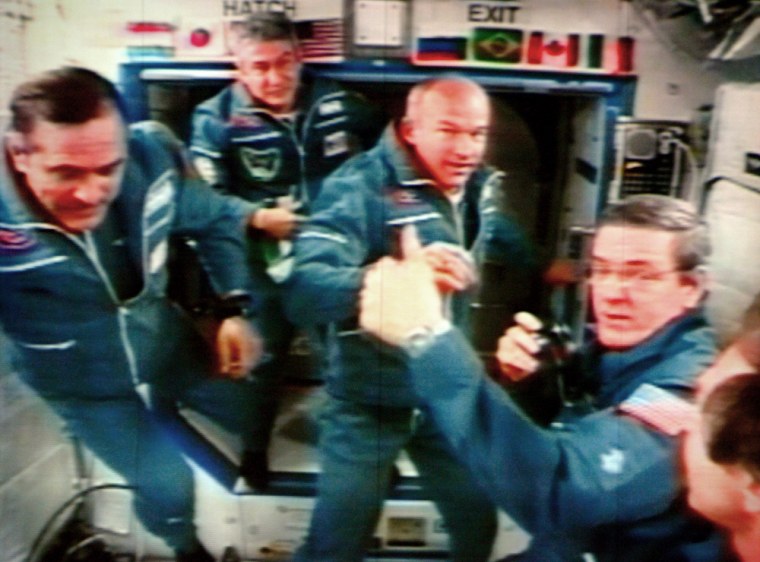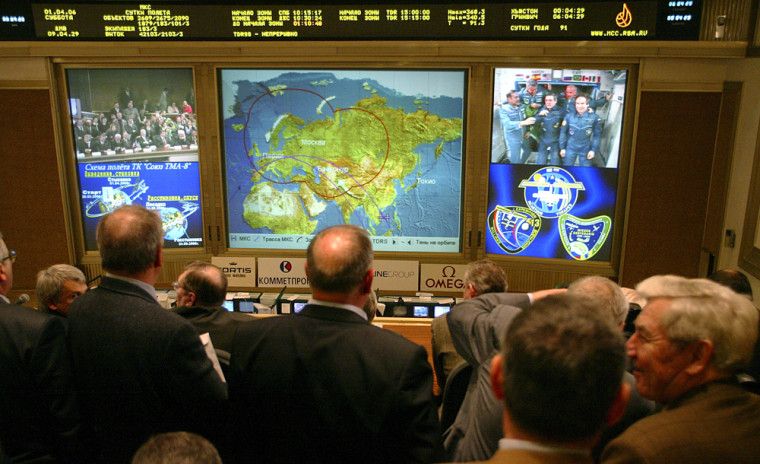A pair of unexpected alarms cut short an airlock campout for two NASA astronauts aboard the international space station, the U.S. space agency said Tuesday.
Expedition 12 commander Bill McArthur and Expedition 13 flight engineer Jeffrey Williams had sealed themselves inside the space station’s U.S.-built Quest airlock after dinner and lowered the atmospheric pressure to purge nitrogen from their bloodstream while they slept. But the activity, designed to test a time-saving procedure for future spacewalks, was terminated after the second of two alarms apparently caused by a software glitch, NASA officials said.
“The teams are now looking at all the data to determine what may have caused the inadvertent alarms that woke up the crew,” NASA spokesman Kyle Herring said during the agency's daily space station commentary.
Two alarms, the second of which prompted mission controllers to scrub the campout, apparently were caused by a data spike that was erroneously reporting a low carbon-dioxide level, Herring said.
“We enjoyed our little adventure last night,” McArthur told NASA flight controllers earlier Tuesday. “It’s a good chance to get into some of the guts of the airlock.”
McArthur said he hoped to learn whether all of the test objectives were accomplished during the curtailed campout.
Kylie Clem, a spokeswoman at NASA's Johnson Space Center in Houston, told Space.comthat the campout was terminated at 12:43 a.m. ET. Flight controllers will go through the data collected from the campout test to determine whether or not another test will be required, she added.
Beating the bends
On Monday, McArthur said the campout would let flight controllers test a new way to flush nitrogen from the body before future spacewalks.
“It’s very important that we try to eliminate the nitrogen in our bloodstream before an EVA (extravehicular activity) to minimize the chance of getting a condition called the bends,” McArthur said during a Monday press conference.

Also known as decompression sickness, the bends can occur during a sudden drop of surrounding pressure that allows nitrogen bubbles to form in the bloodstream and cause pain in the joints and chest, cramps or paralysis if unchecked. On Earth, it can afflict deep-sea divers who ascend too quickly.
While divers surface gradually from a deep expedition to prevent the bends, astronauts spend hours breathing pure oxygen to flush nitrogen from their bodies prior to spacewalks.
During Monday’s test, McArthur and Williams hauled their sleeping bags and other personal items into the elevator-sized Quest airlock, sealed the hatch behind them, and then lowered the pressure inside from the station’s standard 14.7 pounds per square inch — or about the same as at sea level on Earth — to 10.2 psi, NASA officials said.
“I’d compare this protocol to how scuba divers avoid the bends,” said Roger Lottridge, a spacewalk systems flight engineer for United Space Alliance at Johnson Space Center, where mission controllers watched over the campout. “Staying in the airlock overnight at the reduced pressure is sort of like that slow rise.”
Long-planned test
Plans for the campout procedure have been in place since the Quest airlock arrived at the ISS in 2001, said Lottridge, adding that the procedure is expected to be used during NASA’s STS-115 shuttle flight in August. Also known as 12A, the STS-115 spaceflight features the installation of a new solar array outside the space station by spacewalking astronauts.
“It probably gets us out the door about 30 minutes to an hour earlier, which for certain flights can be very beneficial,” Lottridge said of the Quest airlock campout. “Especially, for instance, on the 12A flight. By getting out there a little earlier, it doesn’t make … the EVA crew members the long pole in the process of getting that solar array activated on the first EVA.”
There are some drawbacks. Unlike on past shuttle flights, where the restroom and kitchen are at hand during the entire crew cabin’s pressure drop to 10.2 psi before a spacewalk, the Quest airlock carries no lavatory or galley.
“The airlock is like a big rig sleeper,” Lottridge said. “You don’t have those amenities.”
The comfort level of the crew and the performance of sensors and hardware designed to watch airlock pressure, carbon-dioxide levels and maintain its atmosphere were watched closely during the test.
“Hopefully we’ll have gathered all the data that the folks on the ground need to validate that function of the airlock,” McArthur said.
Crew change under way
McArthur and Williams are in the midst of a station crew change.
McArthur and Expedition 12 flight engineer Valery Tokarev are handing control of the ISS over to Williams and Expedition 13 commander Pavel Vinogradov, who arrived at the station early Saturday with Marcos Pontes, Brazil’s first astronaut. Pontes will return to Earth on April 8 with the Expedition 12 astronauts, who have lived aboard the space station since October 2005.
“We’re ready to go home,” Tokarev said. “We have accomplished all our tasks, we are happy.”
